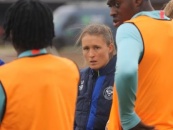Women and Lacrosse
20 de Octubre de 2023 a las 15:52
.jpg)
Photo courtesy of Greg Fiume, NCAA Photos via Getty Images
By Gary Groob Columnist and Co-Host of NLL Talk on Spanglish Sports World and Spanglish World Networks
TORONTO. - I have talked extensively over the last number of weeks about men's lacrosse. Discussing everything from Junior to Senior, Amateur to Professional. A topic I haven't spent a lot of time on is the women's game, and while the object is the same, the game itself is quite different.
The origins of the game:
The first modern women's lacrosse game was played in 1890 at the St Leonards School in Scotland, where women's lacrosse had been introduced by Louisa Lumsden. A British school teacher, Cara Gascoigne, at Sweet Briar College, started club lacrosse at that college in 1914. One of Lumsden's students, Rosabelle Sinclair, established the first women's lacrosse team in the United States at the Bryn Mawr School in Baltimore, Maryland in 1926. The first women's inter-collegiate game was held between Sweet Briar College and The College of William and Mary in 1941.
Rules:
Played with twelve players (including a goalie). The duration of the game is sixty minutes and is divided into quarters. Team's are allowed two 2-minute timeouts per game. A timeout can be requested by the coach or any player on the field, after a goal is scored, or the requester's team has full possession of the ball.
Where things get different is the equipment used. Women's Lacrosse sticks have restrictions. They must be a certain length, and the pocket must be shallow enough to show the ball above the side when held at eye level. With rule modifications, the stick is now more similar to the men's stick, with a deeper pocket and more rounded head.
Before a game can begin, every stick that each player is planning on using in the game must be approved by the referee based on a set of standards created by the U.S. Lacrosse and NCAA. After someone scores a goal, the referee has the right to ask to check her stick. If the stick's pocket is too deep or the stick does not follow the standards, the goal will be called back. Also, on a winning shot the other team is allowed to challenge the player's stick.
Women are only required to wear eyewear or lacrosse goggles and a mouth guard. Internationally, women are only required to wear a mouthguard, and have the option to play without protective goggles.
In women's lacrosse, players may only check if the check is directed away from the ball carrier's head. Also, players may only check using the side of their stick. If caught by one of the referees using the flat of the head, it will be called as a "held check" and the opposing team will get the ball.
"Lacrosse, as women play it, is an orderly pastime that has little in common with the men's tribal warfare version except the long-handled racket or crosse (stick) that gives the sport its name. It's true that the object in both the men's and women's lacrosse is to send a ball through a goal by means of the racket, but whereas men resort to brute strength the women depend solely on skill."
- Rosabelle Sinclair
International competition:
Beginning in 1972, the sport was governed internationally by the International Federation of Women's Lacrosse Associations (IFWLA). The formation of the IFWLA actually predated that of the corresponding body for men's lacrosse, the International Lacrosse Federation (ILF), by two years. In August 2008, after negotiations lasting four years, the IFWLA and ILF agreed to merge into a single governing body, the Federation of International Lacrosse (FIL). All tournaments operated by the IFWLA have been taken over by the FIL.
Notable Players:
Taylor Cummings:
- Youngest woman and only three-time winner of the Tewaaraton Trophy (2014, 2015, 2016)
- Two-time winner of the Honda Sports Award, two-time champion and three-time IWLCA All-American for the Maryland Terrapins women's lacrosse team
- Big Ten Female Athlete of the Year (2015), - Member of United States women's national lacrosse team
Katie Schwarzmann:
- Two-time winner of the Tewaaraton Trophy (2012, 2013)
- Member of United States women's national lacrosse team.
Hannah Nielsen:
- Two-time Tewaaraton Trophy winner (2008, 2009)
- Two-time winner of the Honda Sports Award
- Four-time champion and three-time IWLCA All-American for the Northwestern Wildcats women's lacrosse team
- Member of Australia women's national lacrosse team.
Ginny Capicchioni:
- First woman to play in a professional men's league for the New Jersey Storm of the National Lacrosse League
Michelle Bowyer:
- Part of first Port Coquitlam girls lacrosse team in the 1970's
- Captained 11 consecutive BC Selects women’s field lacrosse championship teams
- Captained Team Canada field lacrosse to bronze at the World Championships in England in 1982
- Finished 4th in 1986 and 1989 at the field World Championships in Philadelphia & Perth, Australia
- Placed 5th in 1997 World Cup in Japan
- 2009 was recognized by the International Federation of Women’s Lacrosse for her outstanding participation and achievement in World Cup competition as a player, assistant coach and head coach for Team Canada Women’s Lacrosse.
- Class of 2020 Canadian Lacrosse Hall of Fame
The popularity of the women's game has grown in leaps and bounds over the last number of years, showcasing the great talent that the women's division has. The future is looking very bright, as the game, and the players gain more and more popularity. With the 2028 Olympics as a goal, more time and money should be granted for development, allowing more exposure of these great athletes to the masses.











Comentarios
escribenos